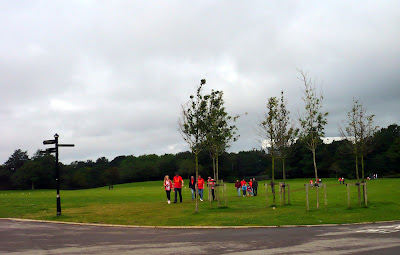 |
| Choragic Monument |
I was going to do 'columns' for ABC Wednesday but when I started to browse my photographs discovered I actually possessed something beginning with C - the Choragic Monument in Tatton Park. The day we visited the park it was what could only be described as changeable, consequently this photo was rather dark, so I popped into Picasa and gave it the heat treatment to show off the classical architecture. Makes it look like the gods are about to descent.
 |
| Tatton Park |
The Choragic Monument of Lysicrates was designed by William Cole of Chester in 1820 and commissioned by Wilbraham Egerton to commemorate his travel through Europe. This was probably a Grand Tour, a traditional journey through Europe taken by wealthy young men to complete a cultural education of the Ancient World and the Renaissance. The monument's inspiration derives from that of the one in ancient Athens celebrating Lysicrates, wealthy patron and leader of the Greek chorus. This piece of statuary was added to the gardens to give a note of finality to the garden tour and terminate the vista of a long broad walk. The monument was a favourite picnicking site for the Egerton family with wonderful view of the parkland.
If the weather was inclement their Neo-classical house would be a pleasant retreat set in the middle of 50 acres of garden. The last in the Egerton line bequeathed it, parkland and gardens to the nation for us all to enjoy.
Lastly here is the inspiration behind the Tatton Park monument, the original Choragic Monument of Lysicrates in Athens.
Choregia defrayed the cost to Ancient Athens of the expense of theatre choruses it was considered a duty to be undertaken by prosperous citizens of Athens. (A Greek Chorus comments with a collective voice on the dramatic action in the play). The choregos (theatre sponsor) was responsible for assembling the theatre chorus, train them, pay them a wage and costume them. There were 15 members in a tragedy chorus, 24 in a comedy chorus and 50 in a dithyramb chorus. I guess that could add up to a tidy sum of money. Each time the choregos competed against the other choregos for first place. The winner was entitled to set up a choragic monument at his own expense to immortalise his name. Not only does the Choragic Monument of Lysicrates of 334BC survive it is also the first use of Corinthian columns.
Lastly here is the inspiration behind the Tatton Park monument, the original Choragic Monument of Lysicrates in Athens.
Choregia defrayed the cost to Ancient Athens of the expense of theatre choruses it was considered a duty to be undertaken by prosperous citizens of Athens. (A Greek Chorus comments with a collective voice on the dramatic action in the play). The choregos (theatre sponsor) was responsible for assembling the theatre chorus, train them, pay them a wage and costume them. There were 15 members in a tragedy chorus, 24 in a comedy chorus and 50 in a dithyramb chorus. I guess that could add up to a tidy sum of money. Each time the choregos competed against the other choregos for first place. The winner was entitled to set up a choragic monument at his own expense to immortalise his name. Not only does the Choragic Monument of Lysicrates of 334BC survive it is also the first use of Corinthian columns.
An entry to ABC Wednesday - a journey through the alphabet.





























